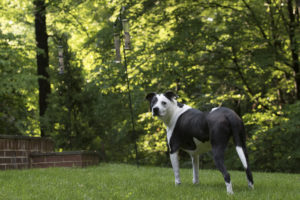Latest Posts
- Have a purpose when backyardingAugust 5 2021
- Study: Time outside alters our microbiomeAugust 4 2021
- Happy National Mutt Day from Mo-MoJuly 27 2021
- New home? Avoid these common mistakes in your yard.July 26 2021
- Infographic: Plan a backyard staycation this summerJuly 22 2021
Categories
Archive
August 22nd

National Dog Day is on Monday, August 26. This year, TurfMutt encourages pet parents to go beyond extra treats, long walks and more belly rubs to celebrate. Honor your dog on National Dog Day and beyond by enhancing her favorite “room” in the house…your yard!
Here are Lucky the TurfMutt’s top tips for creating a pet-friendly yard this fall.
Think about what your dog needs. Many of us reassess our yards in the fall and consider where things are planted and what features we want to enhance. Pets love living landscapes and love being in your yard. What does your dog need the most? A place to romp and exercise? Somewhere to relax in the shade for an afternoon nap?
If you are reseeding your yard this fall, pick “dog-proof” ground coverings. Grass is one of the best ground coverings around because it can handle the wear and tear that comes with pets and children. Bermuda and buffalo grass are especially hardy, and they are drought-resistant, too. Grass also delivers great health benefits for you and your family by producing oxygen, sequestering carbon, capturing water runoff, and cleaning and filtering rain water.
Select appropriate plants. For areas near your garden paths, select plants that have soft foliage, but are still sturdy enough to withstand a little canine “ruff”-housing. If your dog is a “plant chewer” be sure to check the ASPCA’s list of toxic and non-toxic garden plants for advice on what known toxic plants to avoid. Also, don’t forget to check the climate map so you can choose the right trees, shrubs, grasses and flowering plants for your climate zone.
Use barriers to keep your dog out of flower or garden beds. Fall is a great time to add barriers to beds that were a challenge for your dog to avoid. A low fence, rocks and other obstacles can encourage your dog to stay out.
Avoid plastic grass. Plastic grass, also known as artificial turf, gets too hot for humans and pets, especially in summer months. A Brigham Young University study revealed that synthetic-turf surface temperatures were 37 degrees higher than asphalt and 86 degrees hotter than natural turf. A 2012 Penn State study found it wasn’t uncommon for temperatures on plastic grass to surpass 150 degrees and to go up to 200 degrees.
Recycle grass clippings. Lawns sequester the largest amount of carbon when they recycle the nitrogen contained in grass clippings. Grass clippings are 90% water, and the remaining 10% is biodegradable. So, take off your lawn mower’s mulching bag and leave your grass clippings on the ground while mowing. The clippings will break down and feed your grass naturally. This practice is known as grasscycling.
For more tips on getting your yard backyard ready for your pets and family, go to SaveLivingLandscapes.com.





